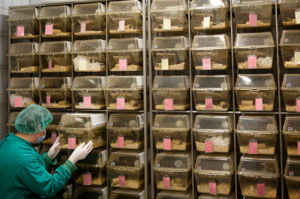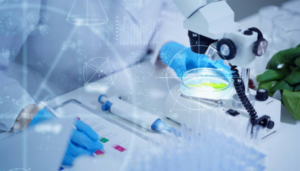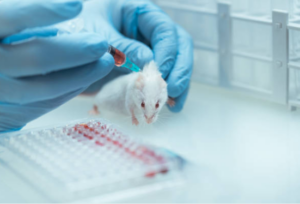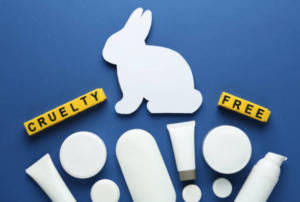A Blemish in Beauty

The world of cosmetics has long been associated with the pursuit of beauty and self-expression. However, beneath the glamour and allure lies a darker reality that many consumers may not be aware of – the practice of animal testing in the cosmetic industry. While the desire for safe and effective products is understandable, the consequences of animal testing are both ethical and scientific. In this exposé, we delve into the hidden world of animal testing in cosmetics, shedding light on its implications for both animals and human health, and exploring the alternative pathways towards cruelty-free beauty.
The Ethical Quandary
The issue of animal testing in the cosmetics industry is a moral quandary that has ignited passionate debates among consumers, scientists, activists, and industry leaders alike. On one hand, there’s a desire for products that are safe for human use, while on the other hand, there’s growing concern for the well-being of animals subjected to these tests. The ethical implications of animal testing raise profound questions about the value of animal lives and the ethical responsibilities of humanity.
Animal testing involves exposing animals to cosmetic products and their ingredients to assess their potential impact on humans. Common tests include skin irritation tests, eye irritation tests, and repeated-dose toxicity tests, all of which can lead to suffering, distress, and sometimes even death for the animals involved. The conditions under which these animals are kept and the procedures they undergo are often far from humane, raising serious ethical questions about the justification for their sacrifice.
The practice of animal testing in the cosmetics industry has long been justified by the argument that it is a necessary step to ensure consumer safety. However, as advancements in science, technology, and ethics have unfolded, this argument is being challenged more than ever before. The myth of necessity surrounding animal testing is being unraveled as alternatives emerge that offer accurate safety assessments while sparing animals from needless suffering.
One of the key factors debunking the myth of necessity is the rapid progress in technology and testing methods. Traditional animal testing methods are often outdated and do not accurately reflect human biology, leading to inconclusive results. In contrast, modern methods such as in vitro testing, computer modeling, and 3D skin models are proving to be far more accurate in predicting human reactions to cosmetic products.
In vitro testing involves using human cells and tissues to simulate the effects of cosmetics on human skin. This method not only eliminates the need for animal testing but also provides insights into how a product will interact with human biology specifically. Companies like Episkin and MatTek have pioneered these methods, creating skin models that mimic human skin’s structure and functionality.
Cutting-edge “organ-on-a-chip” technology takes testing even further by recreating the functionality of entire organs on tiny microchips. These chips replicate the behavior of organs like the liver and lungs, offering a more holistic view of how cosmetic ingredients are metabolized in the body. This technology holds immense promise for accurately assessing safety without resorting to animal testing.
Sophisticated computer models can simulate the interactions between cosmetic ingredients and human biology. These simulations take into account various factors such as chemical structure, biological pathways, and even environmental conditions. Computer modeling offers rapid insights into potential risks without the need for animal subjects.

The Scientific Limitations
Contrary to the perception that animal testing guarantees safety, the differences in biology and physiology between humans and animals often lead to misleading results. What might be safe for one species could be harmful to another. This gap in accuracy poses risks to human consumers who assume that products tested on animals are safe for them as well.
The principle of extrapolation—applying results obtained from animals to humans—is deeply flawed due to the variability in how different species respond to substances. A product that is deemed safe for animals may still pose risks to humans, or vice versa. For instance, aspirin is toxic to cats but safe for humans, highlighting the potential for erroneous conclusions when relying solely on animal testing.
Allergic reactions to cosmetics are a significant concern, yet the testing of allergens on animals often yields inconclusive results. Animals may not exhibit the same allergic responses as humans, leading to false-negative results. Additionally, the development of allergic reactions is influenced by genetic factors that differ between species.
Animal tests focus on identifying immediate reactions such as skin irritation or eye damage, neglecting the potential long-term effects that cosmetic products may have on human health. The inability of animal testing to predict chronic effects like carcinogenicity, reproductive toxicity, and endocrine disruption raises critical concerns about the overall safety of cosmetics.
The tragic historical example of thalidomide serves as a stark reminder of the limitations of animal testing. The drug was considered safe in animal testing but resulted in severe birth defects when taken by pregnant women. This catastrophic event underscored the need for testing methods that accurately reflect human responses.

In Vitro Testing
In vitro testing, which involves using human cells and tissues to simulate human reactions, has emerged as a leading alternative to animal testing. This method offers a more accurate reflection of how cosmetic products interact with human biology. For instance, reconstructed human skin models provide insights into skin irritation, corrosion, and even the absorption of chemicals. By mimicking human responses, in vitro testing eliminates the need for animals and reduces the potential for misleading results.
Microfluidic Devices
Microfluidic devices, often referred to as “organs-on-a-chip,” replicate the functions of organs within a lab setting. These miniature systems recreate the dynamics of organs such as the liver, lung, and kidney, allowing scientists to observe how cosmetic ingredients are metabolized and processed in the body. These devices not only offer a more accurate assessment of safety but also provide insights into systemic effects that animal tests cannot replicate.
Advanced Computer Modeling
Sophisticated computer models have the capacity to simulate the interactions between cosmetic ingredients and human biology. By considering factors such as chemical structure, biological pathways, and environmental conditions, these simulations can predict the potential effects of products on human health. These models not only save time and resources but also provide a cruelty-free means of assessing safety.
Human Skin-on-a-Chip
The development of human skin-on-a-chip technology marks a significant step forward in cosmetic testing. These 3D skin models replicate the complexity of human skin, including its layers and functions. Researchers can expose these models to cosmetics to observe reactions and effects, providing a highly accurate alternative to traditional animal testing for skin irritation and corrosion.

Global Shift Towards Compassion
One of the most impactful milestones in the global shift towards cruelty-free cosmetics is the European Union’s ban on animal testing for cosmetics. Implemented in 2013, this ban not only prohibits animal testing within the EU but also bans the sale of cosmetic products tested on animals. This groundbreaking move has set a precedent for other regions to reevaluate their testing practices and prioritize cruelty-free alternatives.
Cruelty-free certifications and logos have become powerful symbols of brands’ commitment to ethical practices. Organizations like Leaping Bunny and PETA offer cruelty-free certifications to brands that pledge not to test their products or ingredients on animals. These certifications empower consumers to make informed choices, aligning their purchases with their values.
Consumers are increasingly demanding transparency and ethical accountability from the cosmetic industry. The rise of social media and online platforms has amplified consumer voices, enabling them to hold brands accountable for their practices. This demand for cruelty-free products has compelled companies to seek alternative testing methods and adapt to evolving consumer expectations.
In response to shifting consumer preferences and changing regulations, many cosmetic brands are voluntarily transitioning to cruelty-free testing methods. Brands that have previously relied on animal testing are now investing in research and development of innovative alternatives to meet consumer demands for ethical products. This shift demonstrates the industry’s willingness to adapt and align with evolving ethical standards.
International initiatives are working to harmonize regulations and encourage the adoption of cruelty-free testing methods worldwide. Organizations such as the Humane Society International (HSI) collaborate with governments and industries to promote alternatives to animal testing and drive change on a global scale.

- Label Scrutiny: Look for symbols and labels indicating cruelty-free status, such as the Leaping Bunny logo or a statement that the product is not tested on animals.
- Research Brands: Investigate the brands you support and choose those that align with your values regarding animal welfare.
- Voice Your Concerns: Consumers have the power to influence change. By advocating for cruelty-free practices, you can encourage brands to prioritize ethical testing methods.
The time has come for the cosmetic industry to shed the outdated practice of animal testing and embrace a future of cruelty-free beauty. The consequences of animal testing – both in terms of ethical implications and scientific limitations – are undeniable. As consumers, we have the opportunity to shape the industry’s trajectory by supporting brands that prioritize compassion and innovation.
By making informed choices and demanding transparency, we can drive the shift towards a new era of beauty that celebrates both human and animal well-being. The unseen consequences of animal testing are a blemish on the beauty industry, but they also offer an opportunity for collective transformation. Together, we can ensure that beauty is truly kind, compassionate, and a reflection of our shared responsibility to protect all living beings.




